When it comes to off-grid touring, nothing provides peace of mind quite like a dependable power setup.
Travelling deep into Australia’s most remote tracks and national parks, I needed solar I could rely on to keep everything running – from the fridge and freezer to my cameras, water system, and even an induction cooker.
That’s why I opted for two 200W Projecta solar panels, mounted permanently on the roof of my Alu-Cab Canopy Camper and wired in parallel. Together, they deliver 400W of solar power, feeding into a 400Ah lithium battery via a Projecta 40A MPPT solar charger. And here’s the kicker – my DC-to-DC charger still isn’t connected, so solar has been the only charging source since I left home. Despite that, these panels have kept me running day in, day out, across some of the most demanding off-grid conditions Australia has to offer.

Setting it up
Mounting the panels was straightforward.
The design of the Projecta units allowed them to sit neatly on the canopy rails without adding unnecessary bulk or creating clearance issues, thanks to the low-profile Razed Products Solar Panel Mounts. They’re robust enough to handle the rough corrugations, bulldust, bush pinstriping and relentless red dirt that come with remote travel.
Wiring them in parallel was a deliberate choice. Some people prefer series for the higher voltage and reduced cable losses, but I wanted redundancy. In a series setup, if one panel is shaded – say by a tree branch or even the way I’ve parked at camp – the whole system suffers. By wiring in parallel, each panel works independently. If one’s compromised, the other still pumps out power. In real-world conditions, that makes a massive difference.
That’s especially true when travelling through varied environments. Out on the Canning Stock Route, shade isn’t much of an issue – it’s wide-open desert with sun blasting down all day. But in places like Mary River National Park or shady campsites in Litchfield, partial shading can cut into your harvest if you’re not careful. Running the panels in parallel has been the right call for me.
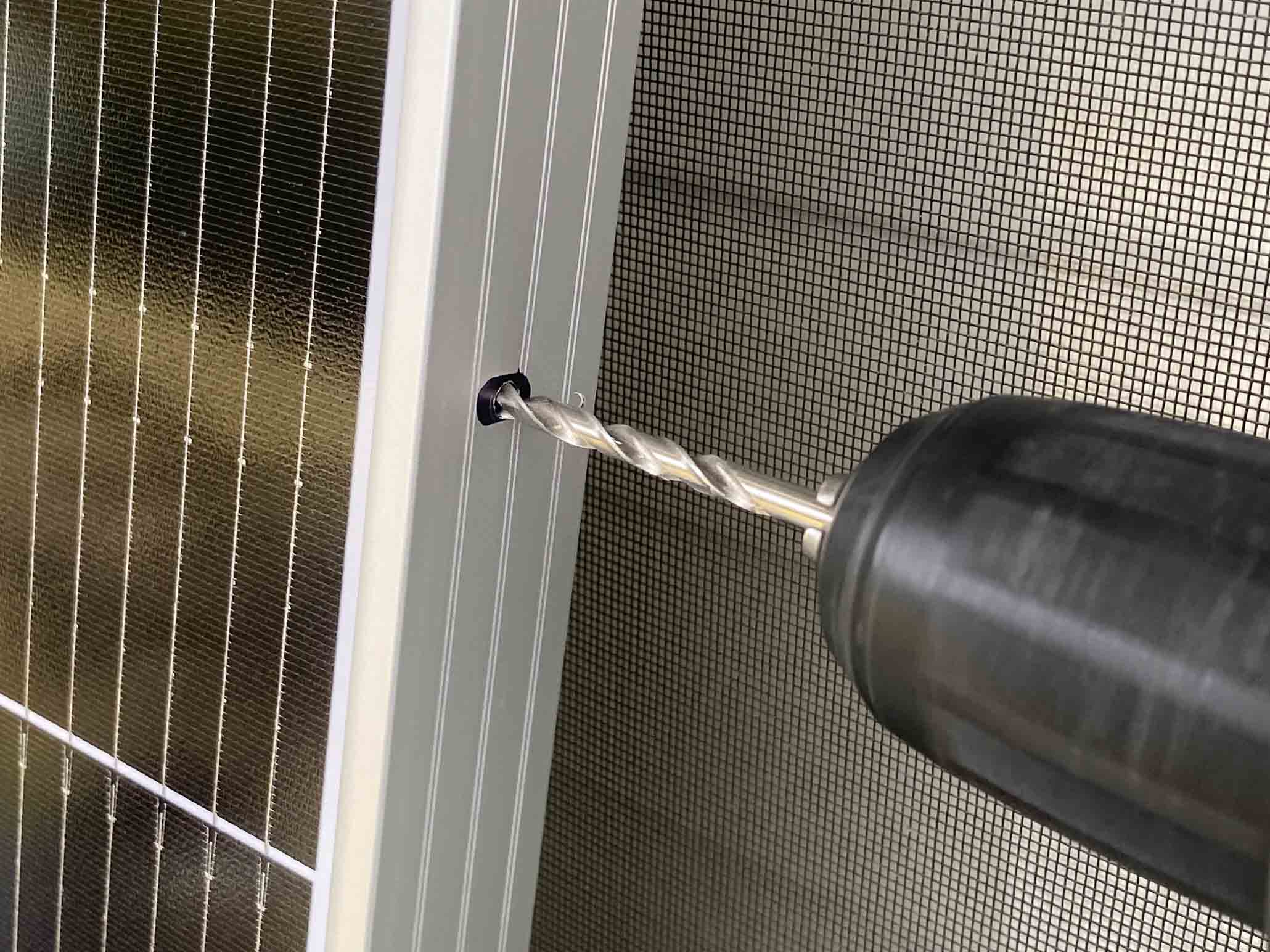
Lithium battery
The Projecta panels are feeding into a 400Ah lithium battery in my canopy.
Lithium has become the go-to choice for serious touring setups thanks to its deep-discharge capability, faster recharge times and lighter weight compared to AGM. But even lithium is useless if it’s not being charged consistently.
That’s where the Projecta panels have impressed me most. I’ve been running solely on solar for weeks, and they’ve kept up with everything I’ve thrown at them – fridge, freezer, water pump, cameras, drone batteries, laptop, phones, lights, even induction cooking. That’s a heavy load, but the battery has taken it all in its stride.
It’s not just about wattage either. Quality panels like these consistently deliver their rated output in good conditions, something cheaper units I’ve tested have failed to do. On a bright day, I can watch the current pour into the battery, and it’s a great feeling knowing I’m harvesting free power while I’m out exploring.

Put to the test
This setup hasn’t been tested in a backyard – it’s been proven across some of the toughest touring environments in Australia.
Canning Stock Route: The ultimate challenge. Weeks off-grid, no services and zero backup if something fails. The Projecta panels didn’t skip a beat. The battery stayed charged every day, even during extended stops. Out here, power isn’t a luxury – it’s survival.
Mary River National Park: A completely different environment – humid, shaded, and full of tree cover. This is where wiring the panels in parallel really paid off. Even with partial shading, I still saw steady input to keep the system happy.
Litchfield National Park: With its mix of waterfalls, shaded camps and variable light, Litchfield is a true test of consistency. The panels handled it with ease.
And here’s the standout: I went 12 straight days relying only on solar to recharge my 400Ah lithium battery – travelling from Katherine in the NT to Marble Bar in WA via the remote Duncan Road and the legendary Canning Stock Route. No DC–DC charger, no alternator input, just pure solar power keeping everything running. That’s a real-world test of endurance, and the Projecta panels passed with flying colours.
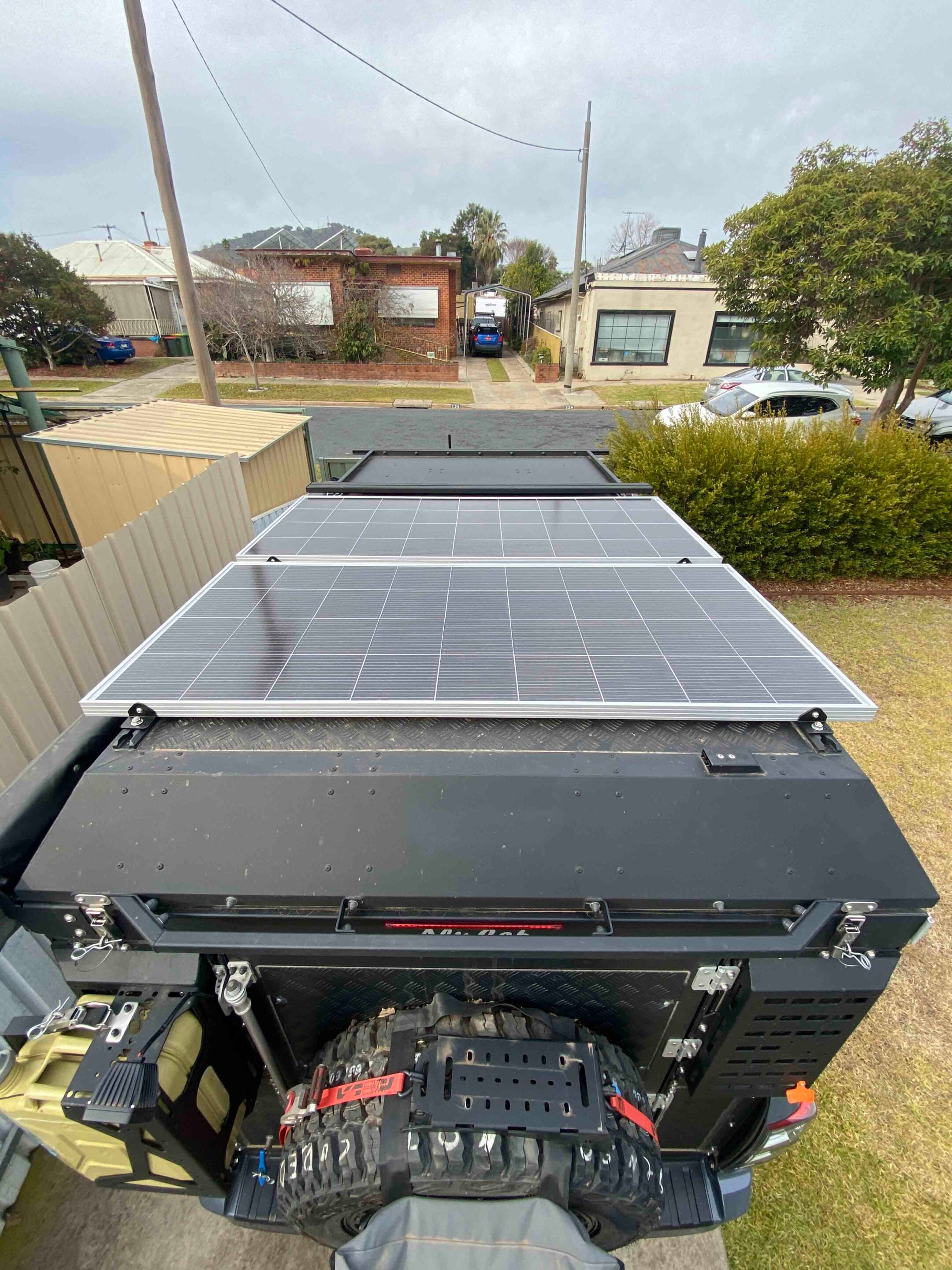
Real-world test
What this setup has delivered, in real-world terms, is freedom. I haven’t had to stress about power once – no need to plug into 240V AC, no reliance on alternator charging.
- Fridge and freezer: Both have run non-stop without missing a beat. Cold food and ice-cold drinks, even in 38°C heat.
- Water system: Always powered, giving me showers, drinking water and washing-up whenever needed.
- Charging gear: Cameras, drones, phones, laptop – all charged, all the time. No rationing power, no hesitation about plugging something in.
- Cooking: The biggest surprise has been being able to run an induction cooker. Normally that’s considered too power-hungry for solar alone, but paired with 400Ah of lithium, the Projecta setup has handled it with ease.
For anyone who’s travelled remotely, you’ll know how much this changes the game. When you can trust your power, you can stay off-grid longer, explore further and travel with absolute confidence.

Key specs
- Type: Monocrystalline fixed panel
- Output: 200W
- Size: 1476mm (L) x 670mm (W) x 35mm (D)
- Frame: Heavy-duty, corrosion-resistant aluminium
- Glass: Toughened, low-iron tempered glass for optimal sunlight capture and long-term durability
- Connectors: Standard MC4 plug-and-play
- Warranty: 1 year (materials and workmanship), 20 years (minimum 80% rated output)
- Best for: Permanent canopy or roof installation on 4x4s, campers, caravans and motorhomes
Verdict
Projecta’s 200W solar panels have proven themselves where it counts. From the harsh desert stretches of the Canning Stock Route to shaded NT campsites, they’ve kept my system running faultlessly.
Managing 12 consecutive days powered only by solar – from Katherine to Marble Bar – is the best proof I could ask for. Wiring them in parallel has paid off big time, delivering consistent charge regardless of shade or cloud. Combined with my 400Ah lithium battery, the setup has turned my canopy into a fully self-sufficient, off-grid powerhouse.
Would I recommend them? Absolutely. If you’re planning extended remote travel and want solar you can rely on – not just for weekends, but for the long haul in the middle of nowhere – these panels are worth every cent. For my touring lifestyle, they’ve been nothing short of outstanding.
- RRP: $450
Pros
- Reliable power output, even in harsh conditions
- Parallel wiring adds redundancy and minimises shading losses
- Built tough for corrugations and rough touring environments
- Plenty of grunt to sustain heavy electrical loads
- Genuine peace of mind when you’re days from the nearest power point
Cons
- Fixed mounting means you can’t move the panels to follow the sun like portable units
- Parallel wiring requires slightly heavier cabling to safely handle the increased current
Rolling down the Stuart Highway after a long day on the road, I was glad to pull into the Adelaide River Inn.
Perched about 112km south of Darwin and 200km north of Katherine, it’s a welcome sight for travellers chasing fuel, food or just a cold beer. The bonus? There’s a caravan park out the back, so you can camp up without leaving the action. That’s exactly what I did – grabbed a site and set about exploring what makes this pub one of the best-known stops in the Top End.
Adelaide River Inn vibes
The place is buzzing. Trucks rumble in, tourists spill out of 4x4s and locals drift across from nearby properties.
The 303 Bar and Bistro sits at the heart of it all – air-conditioned and lined with Territory memorabilia. Out back, the beer garden sprawls with shaded tables, a small kids’ playground and the familiar clack of a pool table. Open daily from 9am to 10pm, it’s the kind of place where you can settle in and feel part of the flow straight away.
Inside the front bar stands the pub’s most famous resident – Charlie the buffalo, immortalised in Crocodile Dundee. He’s still pulling a crowd decades after his big-screen debut.
But Charlie isn’t the only giant here. The Inn is also home to Jock the croc – a five-metre, 720kg saltie who once terrorised boats around Borroloola. He eventually met his match and has since been preserved, taking pride of place as another reminder that in the NT, nature always calls the shots.
By late afternoon, the beer garden fills with chatter as Happy Hour rolls around – schooners $6.50 and house wine $4.50 from 5pm to 6pm (at the time of writing) – with live entertainment keeping the vibe going. A steady crowd gathers for “Jag the Joker”, a daily punt where tickets are $2 each or six for $10. Add in Keno flickering in the background and the atmosphere feels like a mix of pub, carnival and country gathering.

The drinks list is extensive, with a solid range of beers on tap, a decent spread of spirits, and plenty of ready-to-drink cans, stubbies and wines. Nothing fancy – just the kind of selection that ensures no one goes thirsty.
I made the rookie mistake of ordering the Barra Burger for lunch. It sounded promising – a fillet of barramundi with lettuce, tomato, beetroot, onion, cheese and aioli, all stacked in a bun with chunky seasoned chips on the side. Unfortunately, it missed the mark. I’d expected a battered fillet but instead got a grilled one that didn’t hold together. Throw in some odd melted cheese and the whole thing quickly fell apart.
Dinner was a different story. I went back to basics and ordered the Premium Scotch Fillet – about 300g of MSA-grade beef, cooked perfectly medium-rare and served with pepper sauce, salad and chunky chips. It was everything you’d want from a Territory pub feed: big, juicy and satisfying after a long day. Lesson learned – when in doubt, stick with the classics.
If you’re more adventurous, the menu’s got a couple of NT specialties worth a go. The Wild Caught Territory Beef Burger is seasoned with native bush spices, while the Territory Croc Burger serves up a patty of 100 per cent croc meat topped with creamy aioli. When in the Top End, why not lean into the local flavour?
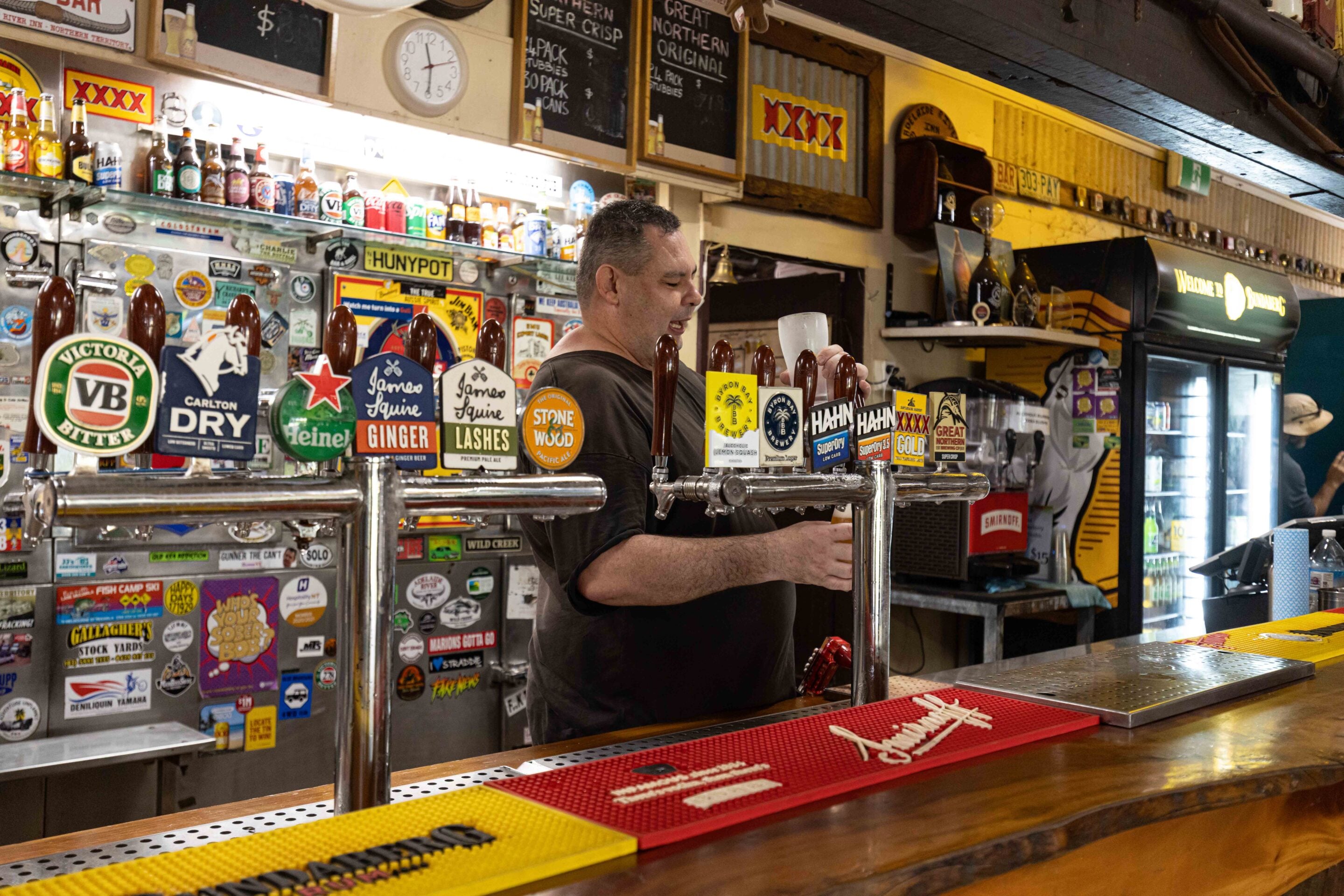
Stay and camp on Stuart Hwy
Camping out the back was simple but spot-on for what I needed.
The caravan park offers a range of accommodation options plus powered and unpowered sites, hot showers, shade and even a pool to wash away the red dust. After a long, hot day on the road, that pool was pure bliss. You can’t book a site here – it’s first come, first served.
The caravan park also features clean amenities and laundry facilities, including coin-operated washing machines and dryers. Two covered camp kitchens with free barbecues are available if you’d rather cook your own than dine at the hotel.
The Adelaide River Inn offers a range of accommodation options to suit different budgets – from fully self-contained ensuite cabins to renovated motel rooms and air-conditioned ensuite budget rooms – all within easy walking distance of the hotel.
My Alu-Cab Canopy Camper made it easy: roll in, fuel up, grab a bite, have a drink and settle in for the night without moving the rig again. By morning, I was recharged and ready to continue north along the Stuart Highway after grabbing a couple of bacon-and-egg toasted sangas from the servo.
Why stop at Adelaide River Inn
The Adelaide River Inn isn’t just a pub – it’s a slice of the Territory; part watering hole, part tourist stop, part history lesson and part local hang-out.
It’s where Charlie the buffalo and Jock the croc remind you that the NT is like nowhere else. It’s where a cold schooner at Happy Hour tastes even better after a long drive. And it’s where travellers like you can camp, eat and have a yarn before heading back out onto the Stuart.
Sure, skip the barra burger – but don’t miss the steak, the beer garden or the buzz of the place. The Adelaide River Inn has well and truly earned its reputation as one of the great Top End pubs.
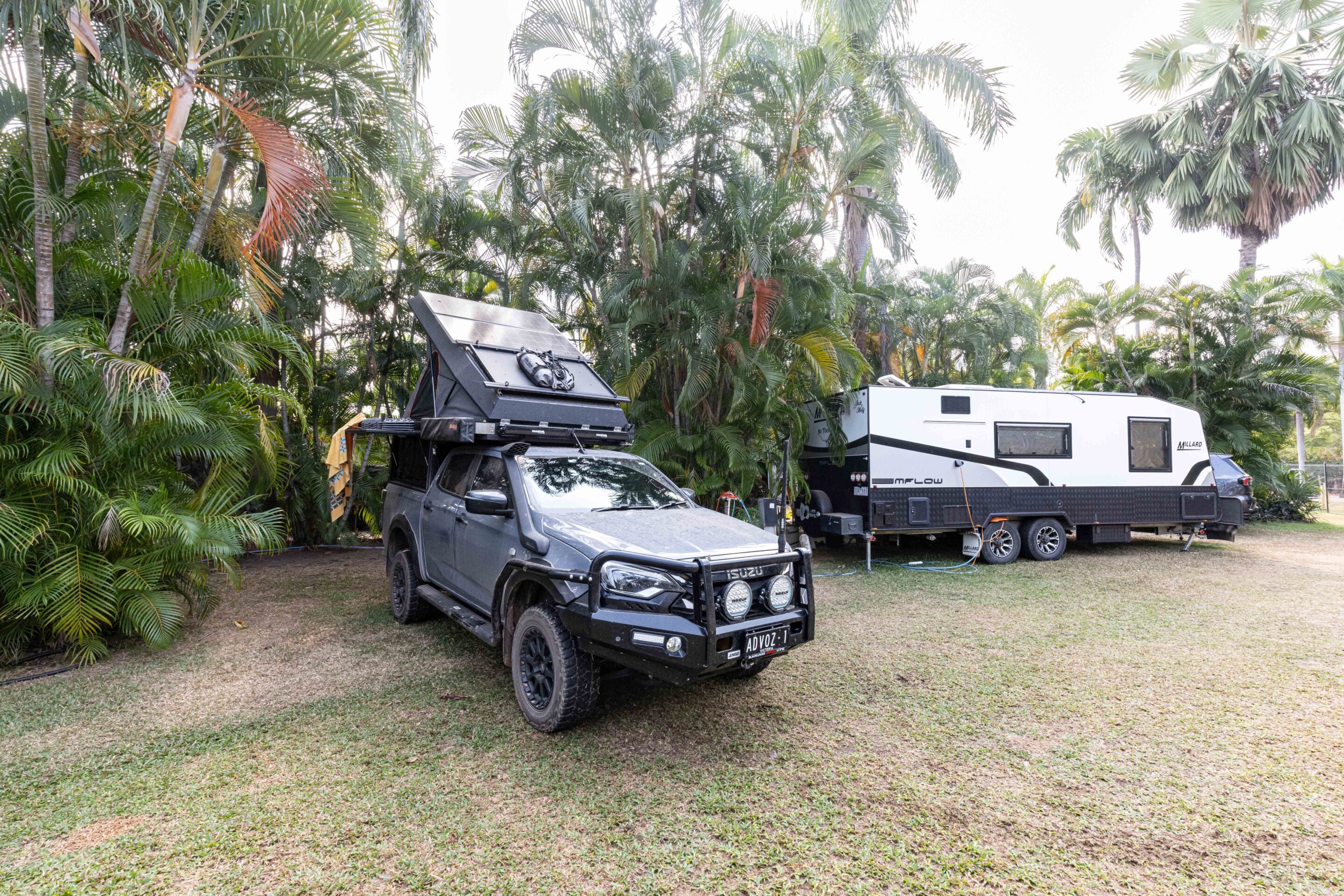
Essential facts
- Location: 106 Stuart Highway, Adelaide River, NT
- Phone: (08) 8976 7047
- Web: www.adelaideriverinntouristpark.com.au
- Beers on tap: XXXX Gold, Carlton Dry, Heineken, James Squire Ginger Beer, James Squire Lashes Pale Ale, Stone & Wood Pacific Ale, Byron Bay Brewery Alcoholic Lemon Squash, Byron Bay Brewery Premium Lager, Hahn Super Dry Low Carb, Hahn Super Dry 3.5, Great Northern Super Crisp and VB.
- Food highlights: Steak Sanga, Chicken Parmy, Wild Caught Territory Barramundi (pan grilled or beer-battered), 303 Bar Beef Burger, Territory Croc Burger, Wild Caught Territory Buffalo Burger, Premium Scotch Fillet, Wagyu Rump, Barbecue Pork Ribs, Boss Drover Bangers & Mash, Fish & Chips, Grilled Calamari, Kids’ Meals, Daily Specials Board.
Long before the INEOS Grenadier touched down in Australia, the team behind Expedition HQ were already deep in the business of building vehicles designed to cross continents, not just sit in carparks.
The roots go back to SLRV Expedition Vehicles, a name well-known to anyone who’s walked a remote outback track and seen one of those big, go-anywhere rigs rolling past – they’re impossible to miss. The business wasn’t born from marketing strategy – it came from a simple, old-fashioned desire to build machinery capable of surviving remote travel.
Heavy-duty 4x4s engineered for corrugations, isolation and long-haul living were its foundation, and that experience in durability and reliability forms the DNA that later became Expedition HQ.
So when the Grenadier arrived in 2023, promising a modern take on a traditional 4WD formula, the SLRV team saw a familiar brief – a tool built around utility, mechanical simplicity and long-range capability. And that’s where Expedition HQ starts.
From Expedition vehicles to expedition builds
Expedition HQ emerged from a practical need. The Grenadier offered a platform with genuine potential, but the Australian aftermarket wasn’t ready for it. Owners needed parts, advice and fitment from people who understood expedition travel, not just weekend accessories.
The logic was straightforward: SLRV knew how to build vehicles for remote work, the Grenadier offered the right bones, and someone needed to support owners with gear that actually matched the vehicle’s intent. So Expedition HQ was formed – a dealership, accessory hub and fit-out centre – all built on the back of experience earned in real-world expedition environments.
“At SLRV we’ve spent decades designing and building vehicles that are expected to cross continents, not just look capable in a car park. That background meant we approached the Grenadier the same way we approach a full expedition build: we assessed it as a platform first,” Warwick Boswerger, Director at SLRV, told 4X4 Australia.
“Chassis strength, drivetrain choice, electrical architecture, serviceability in remote areas and long-term durability all came under the microscope. The Grenadier impressed us because it didn’t require “fixing” at a foundational level – it only needed refining for purpose. That’s a very different starting point to most modern 4x4s.”
A workshop first, a shop second
What sets Expedition HQ apart is that its history is mechanical and practical, not retail. This isn’t the story of a shop expanding into fitment. It’s the story of a fitment and expedition specialist expanding into sales and parts. They were building serious touring vehicles before the Grenadier arrived, solving remote-travel problems before the showroom opened and designing components before EXSPEC became a brand.
That lineage matters, because it means the advice comes from use, not catalogues.
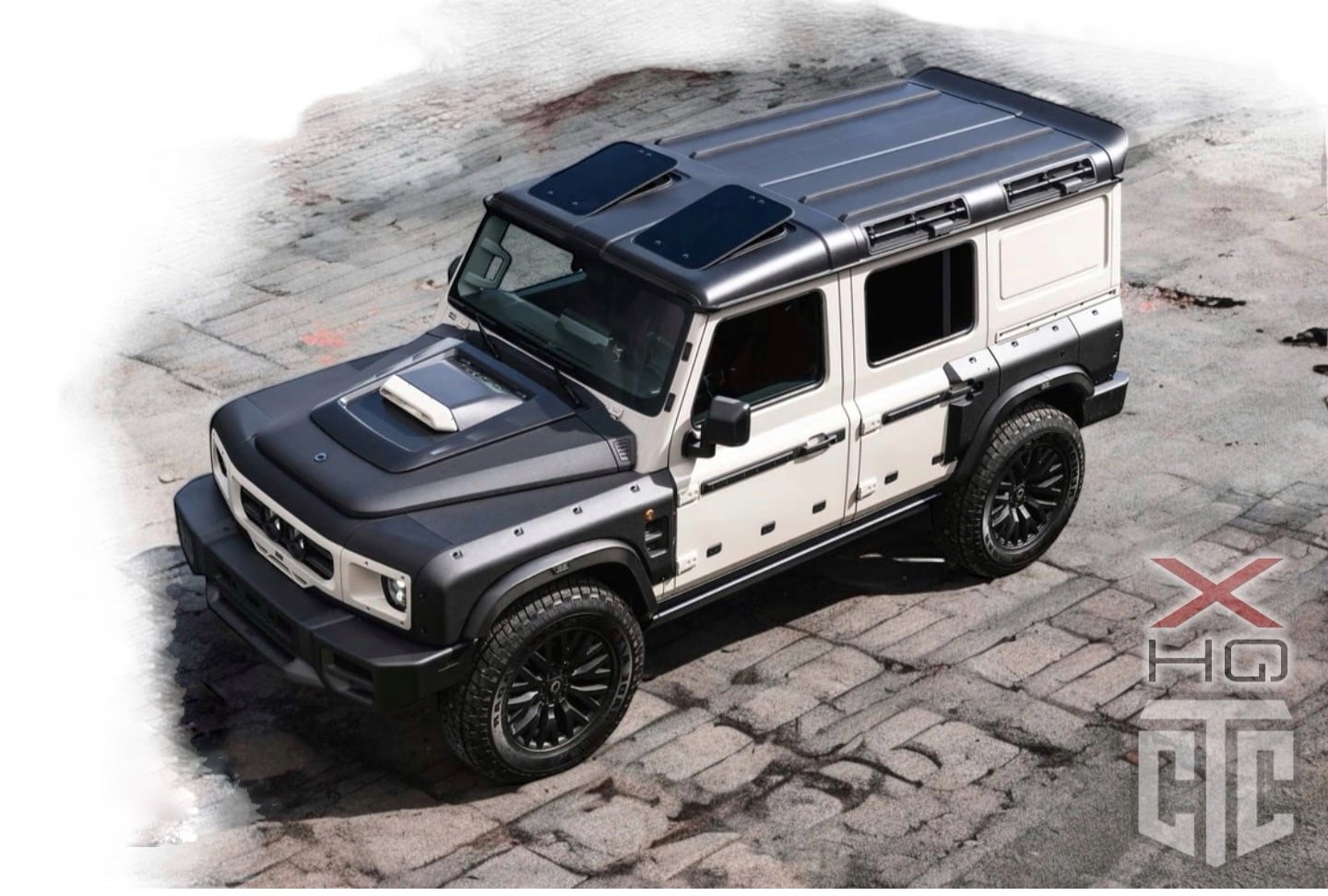
Why the Grenadier fit the philosophy
Expedition HQ didn’t back the Grenadier because it was hyped. They backed it because it’s built on a ladder chassis, uses proven mechanical components and is engineered around function. The platform suits Australian touring, station work and remote travel. And for a workshop built on expedition travel – not mall-crawling – that mattered.
The Australian aftermarket didn’t immediately deliver what the Grenadier needed, so Expedition HQ did what anyone with real expedition history would do – they built their own. Essentially EXSPEC was a response to gaps in available equipment, the demands of remote touring and the needs of working vehicles. The gear was designed around durability first and aesthetics second.
“Australia still demands genuine, mechanical 4WDs that can handle distance, heat, corrugations and isolation. The Grenadier arrived at a time when that segment was shrinking,” said Boswerger. “For Expedition HQ, it filled a gap we’d been watching widen for years – customers wanting a modern vehicle, but without the fragility and complexity that can limit remote travel. It also allowed us to offer something that could be driven daily, then prepared properly for serious off-grid travel without fighting against the vehicle’s original design intent.
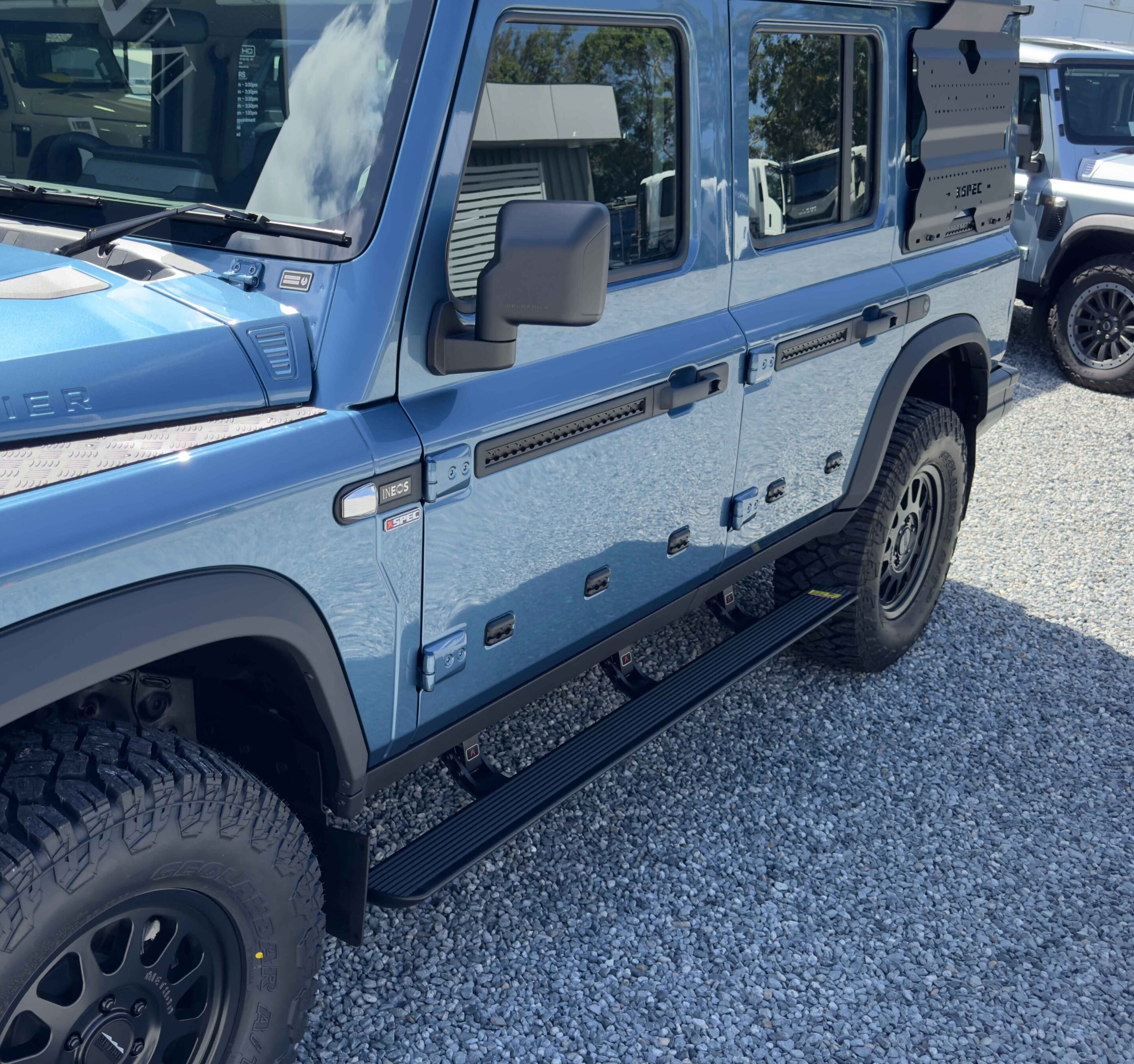
“The Grenadier is unapologetically functional. Ladder frame, solid axles, proper transfer case, mechanical switches and a focus on longevity over trends. That mirrors SLRV’s philosophy exactly. We build tools, not toys. Vehicles that earn their keep through reliability, repairability and real-world usability. The Grenadier felt like it was designed by people who actually understood what happens to vehicles after 200,000 kilometres of hard use,” added Boswerger.
If you walk into Expedition HQ today, you’ll see Grenadiers lined up in various build stages, accessories tested and fitted on real customer vehicles, and EXSPEC components developed from on-road feedback. You’ll also find a team who speak the language of touring, repairs and capability – not marketing.
But the important part isn’t what they sell now. It’s why they sell it. Because their story didn’t begin with the Grenadier. It began with expedition travel – and the Grenadier simply aligned with the philosophy they already lived by.
“We’re not a retail-only operation,” Boswerger told us. “Expedition HQ grew out of vehicle design, fabrication, field testing and recovery experience. We’ve broken vehicles in deserts, repaired them on tracks and lived out of them for months at a time. That means when we talk about modifications, servicing or set-ups, it’s not theoretical. It’s based on what fails, what survives and what actually makes life easier when you’re days from the nearest town.”
XSPEC drawer system
The XSPEC drawer system for the Grenadier is a good example of a piece of gear designed for durability first, aesthetics second.
“It was designed as a load-bearing storage solution first, not a furniture piece. The structure is built to handle constant vibration, heavy payloads and long-term use on corrugations, with robust materials, solid mounting points and simple, proven hardware,” said Boswerger. “It’s not about glossy finishes or tight tolerances that only work when the vehicle is new — it’s about drawers that still slide properly after years of dust, heat and abuse. The look is deliberately understated, because in remote travel reliability always comes before appearance.”
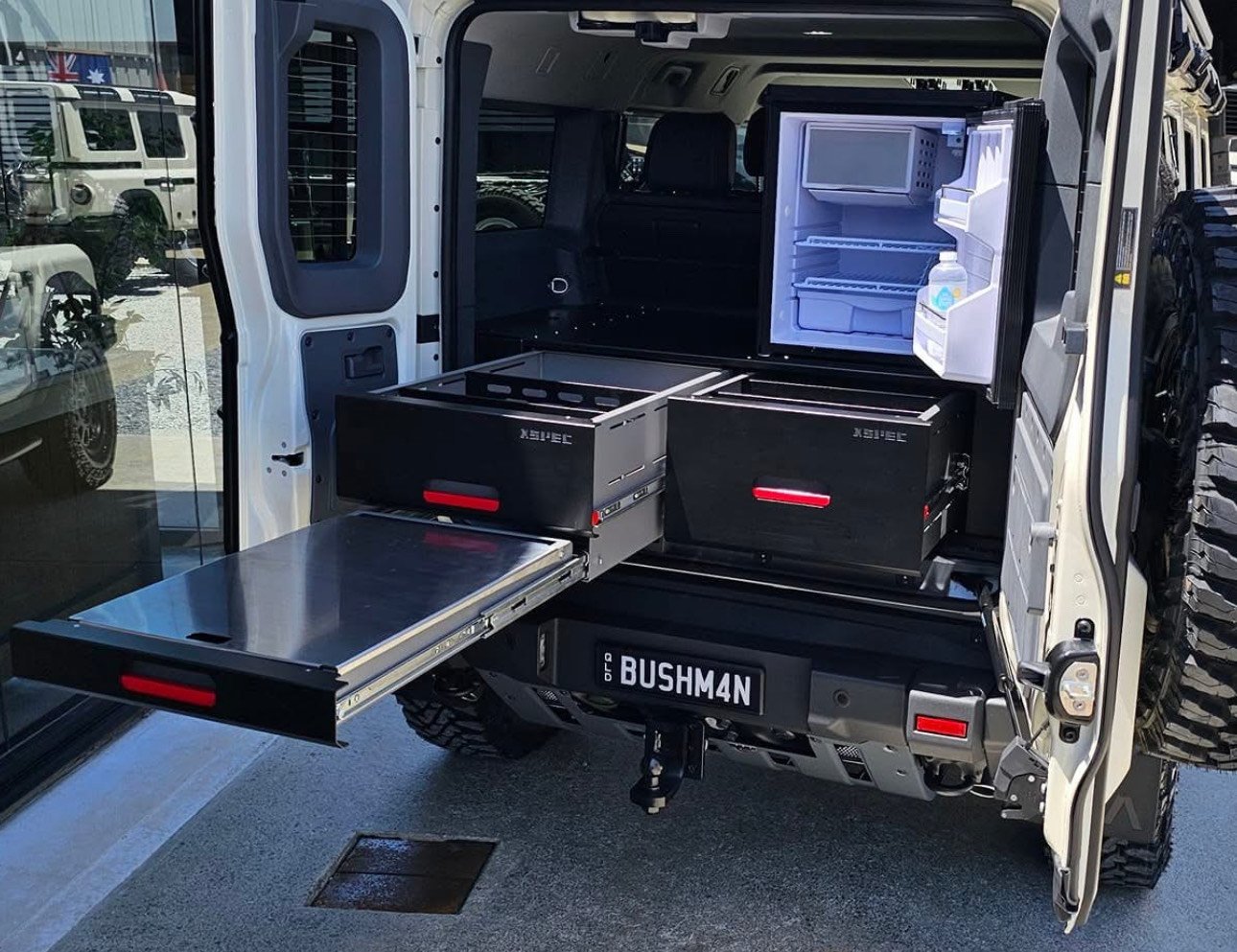
What’s next?
The Grenadier is a key platform for Expedition HQ moving forward, particularly as they expand purpose-built touring and expedition solutions around it.
“Beyond that, we will continue doing what we’ve always done: Developing vehicles and systems for serious travel,” said Boswerger. “Whether that’s compact expedition platforms, advanced electrical solutions or complete off-grid vehicles. The common thread remains the same – durability, function and real-world capability.”
Why the Ranger Was the Clear Choice
For Stuart, owning a ute has always been about more than practicality. It’s about safety for his family, capability for his work, and the freedom to get outdoors whenever the opportunity comes up. After doing his homework, comparing models, and thinking long-term, he landed on a vehicle that ticks every box: the Ford Ranger PX3 XLT 3.2-litre diesel dual-cab — one of the final PX3 models.
Life With the PX3 XLT
Three years in, Stuart’s confidence hasn’t wavered. His Ranger is covered by a five-year warranty, including parts, and he keeps it serviced at the Ford centre in Brookvale.
Most of his driving is close to home on the Northern Beaches. Living in Allambie Heights means short, frequent trips — school drop-offs, commuting to work, and errands within five kilometres of home. But that everyday ease is exactly what he loves. The Ranger feels steady, predictable and comfortable, whether he’s carrying gear, the family, or both.
When the Ranger Needs to Work Hard — It Does
Stuart has put the Ranger to the test with towing, too. One of his standout moments was hiring a 15-foot caravan in Western Sydney and heading up to the Central Coast with his wife and son.
It wasn’t just the towing ability that impressed him — it was the confidence. The 3.2-litre diesel had all the power he needed for overtaking on the highway, and he never felt unsettled or underpowered.

Taking the Ranger Off-Road — Including the Stockton Beach Sand Dunes
Stuart loves getting the Ranger off the bitumen, and he’s taken it through challenging terrain. A favourite is a track outside Goulburn, featuring steep climbs, river crossings and wombat holes. The PX3 XLT handles it all — stable, capable and fun.

A Ute That Fits Every Part of Stuart’s Life
For Stuart, the PX3 XLT isn’t just a vehicle. It’s a safe family car, a reliable workhorse, and an adventure-ready 4WD that opens the door to experiences — from local errands to off-road weekends to unexpected dune-driving detours. It’s the capability, comfort and confidence that keep him loving it every day.
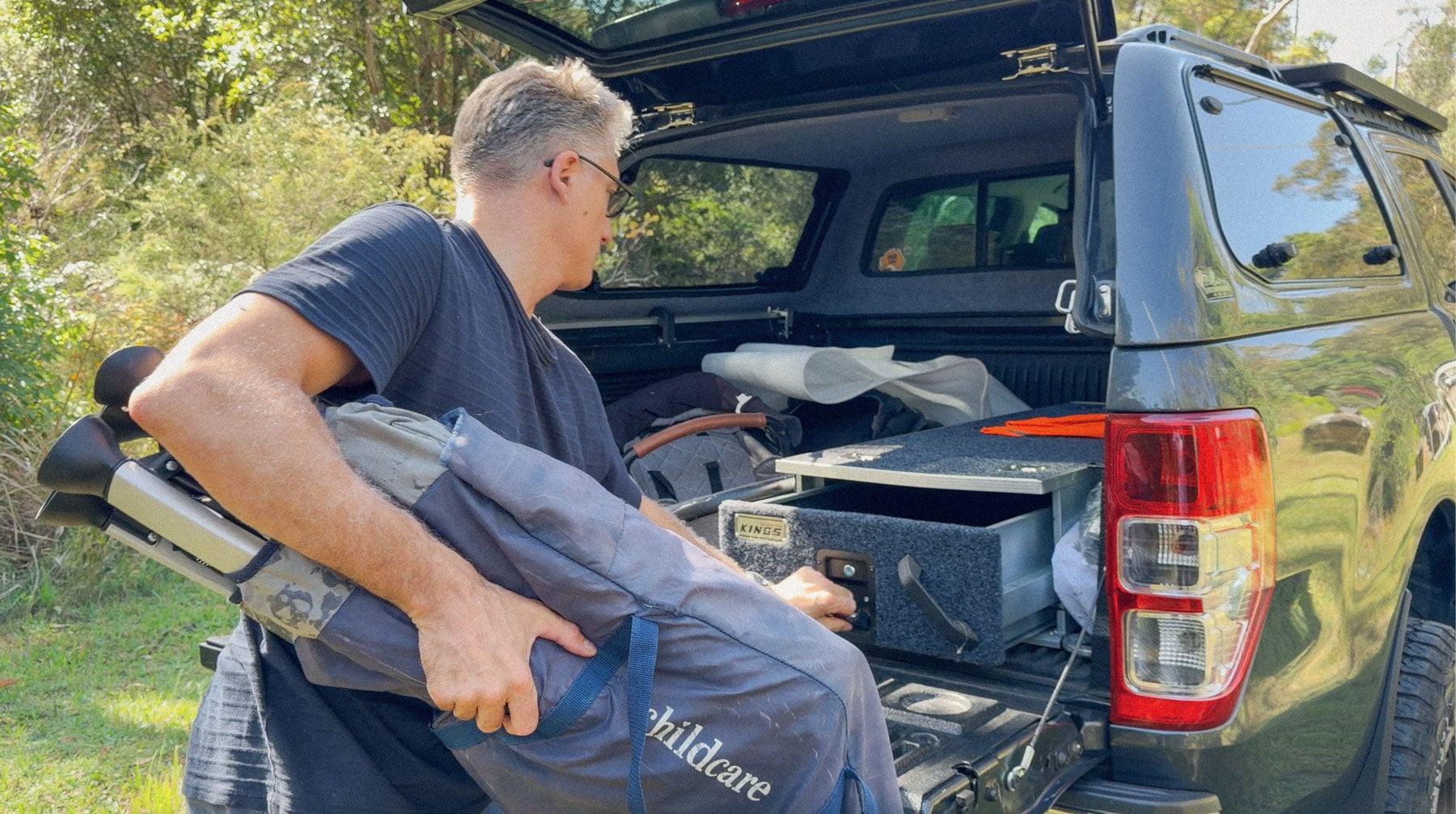
Why the Wildtrak Was the Right Fit for Leigh
For Melbourne gym owner Leigh Whitney, the search for a new ute was all about finding a vehicle that could match his active family lifestyle. After test-driving multiple models and diving deep into 4×4 comparisons, the next-gen Ford Ranger Wildtrak consistently came out on top. It had every feature he wanted, the right blend of capability and value, and a reputation for comfort and usability that suited their five-person household perfectly.
Life With the Next-Gen Ranger
Stepping out of his eight-year-old BT-50 and into the Wildtrak felt like shifting forward a generation. The technology alone — adaptive cruise control, driver-awareness systems, Apple CarPlay and the large central display — transformed Leigh’s day-to-day driving. Whether he’s commuting around Hampton, running errands for his gym Sweat Master, or doing school runs, the Wildtrak feels refined, intuitive and surprisingly easy to manoeuvre.
Family Adventures, Mountain Bikes and Snow Trips
Weekends for the Whitney family revolve around activity — mountain biking, sport, and longer road trips whenever time allows. The Ranger’s tub effortlessly fits three or four bikes, made even easier with the addition of a rack and the electric roller shutter. On bigger trips, everything goes in the back — wet, dirty, bulky, it doesn’t matter — and the Wildtrak never feels weighed down.
Snow destinations like Thredbo, Perisher and Jindabyne are regular stops on their calendar. With five on board and a full load of gear, the Ranger stays stable and smooth, making long-distance runs feel effortless. Now that Leigh has a proper 4×4 — not just a 4×2 — he’s excited to explore more trails in the mountains and make four-wheel driving a bigger part of future trips.
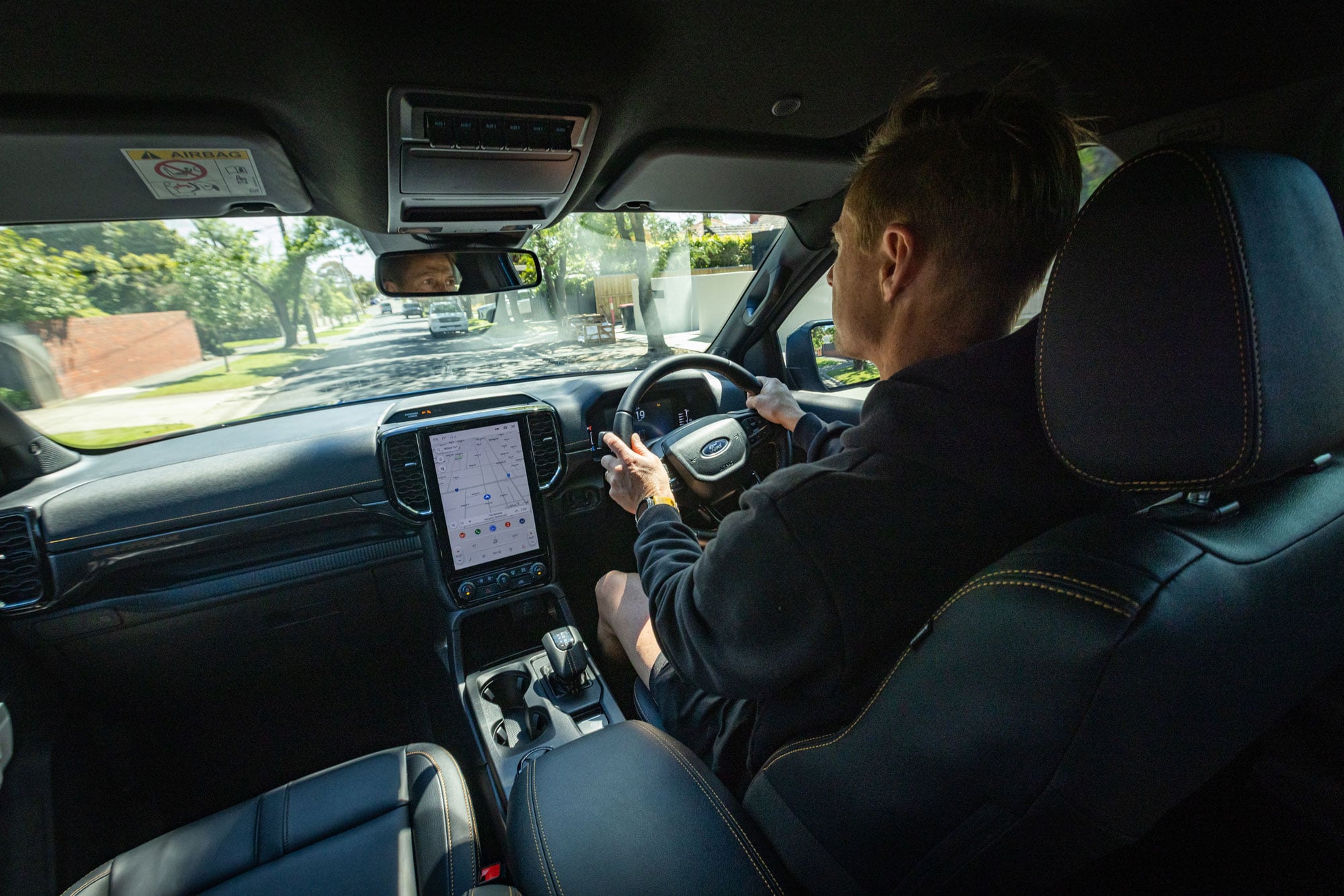
The Comfort and Tech That Make Long Drives Easy
Compared to his previous utes, the Wildtrak’s ride quality stands out immediately. The adaptive cruise control takes the fatigue out of long drives, while the advanced lighting system — which automatically adjusts to highlight dark patches on country roads — has become a favourite feature for family trips to Sydney. The whole vehicle simply feels designed around effortless travel.

A Versatile Ute Built for Their Busy Family Lifestyle
What Leigh appreciates most is the Wildtrak’s versatility. It handles weekday errands as easily as it handles long-haul family travel, outdoor adventures and off-road plans. His young son loves the tech and the “cool-factor”, his mates rate the look, and Leigh sees it as a ute that enhances how they live — making every trip smoother, easier and more enjoyable. For a family constantly on the move, the Ranger fits perfectly into every part of the lifestyle they love.
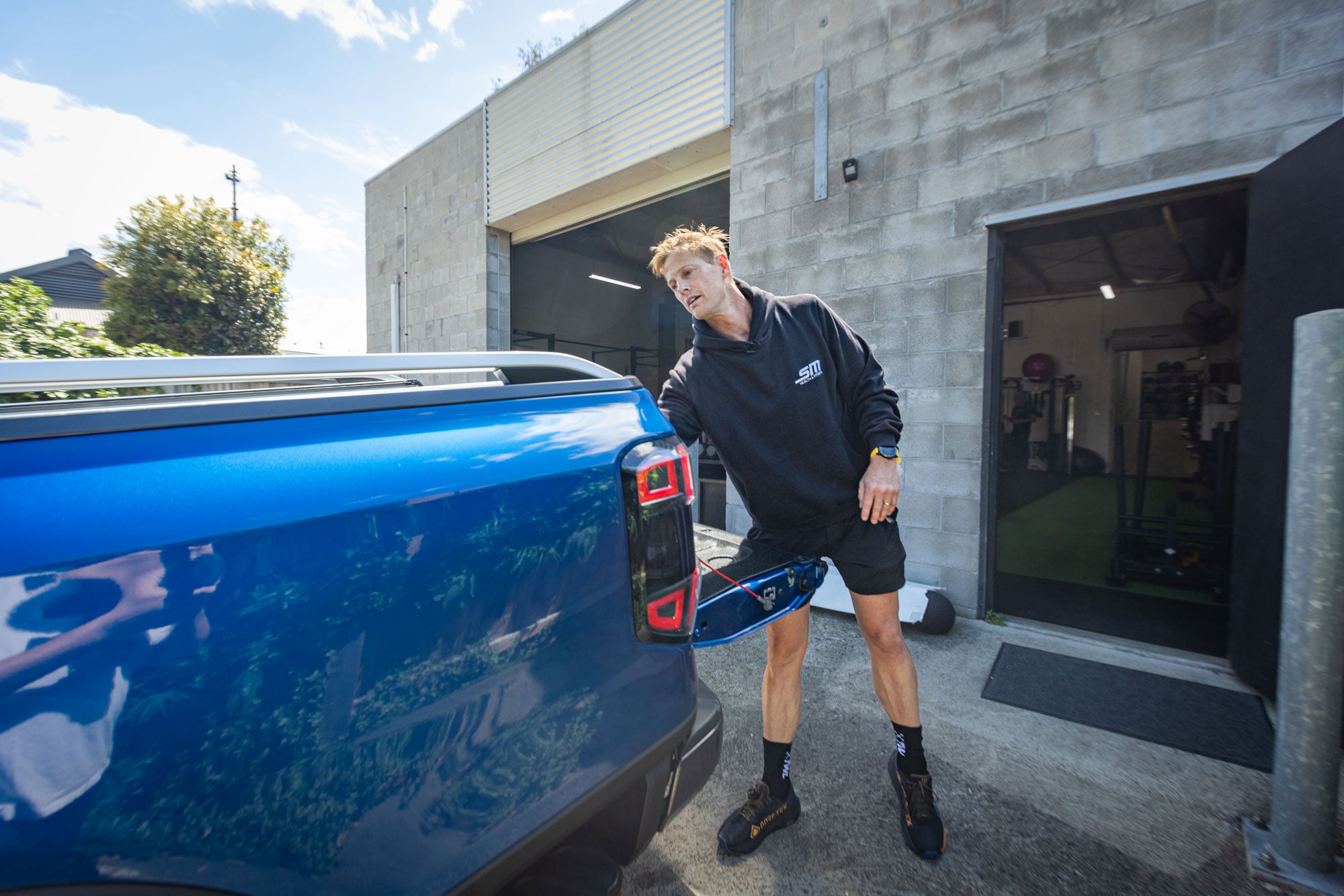
Why Connor Chose the Ranger
For Connor McNally, an event manager for Cricket Australia, life is constantly moving — early mornings, shifting venues, and quick escapes whenever time allows. When he bought his 2016 Ford Ranger toward the end of the COVID-era market chaos, he needed a ute that was powerful, affordable and ready for anything. The Ranger stood out for its real-world capability: strong towing performance, rear diff lock as standard, and the reliability he could trust day in, day out.
How the Ranger Fits His Work and Travel
Across Melbourne and beyond, Connor uses the Ranger as a mobile workspace. The metal canopy and custom rear setup let him haul equipment between offices and event sites without fuss. But once the work week wraps, the Ranger transforms into his getaway vehicle. With a dual-battery system and fridge running full-time, he can throw a swag in the back, hook up a trailer or take off for a spontaneous winter trip with almost zero prep.
Towing, Trips and Real-World Capability
What Connor values most is how consistently the Ranger delivers. From towing his 1,600kg boat to running long highway stretches, it feels surefooted and strong — a big step up from other vehicles he’s towed with, including an MU-X. Even in Tasmania’s freezing August weather or South Australia’s 38-degree heat, the Ranger never faltered. And with a lift and plenty of clearance, it’s taken him deep into the kind of tracks he lives for.

Taking the Ranger Further — From Tasmania to the Gibb River Road
Connor’s Ranger has carried him across some of the most memorable corners of the country: the wild west coast of Tasmania, the sweeping beaches of Rapid Bay, and iconic outback favourites like Cash Island, the Gibb River Road and the Dampier Peninsula. Whether he’s travelling solo or with his partner, the Ranger has even doubled as home for month-long stretches — something few vehicles can genuinely handle.

A Dependable Companion for Every Chapter of His Life
At close to 240,000km, with dents and scratches inherited from previous owners, Connor’s Ranger wears its history proudly. To him, that’s the beauty of it. It’s dependable, capable and always ready for what’s next. Whether towing, camping or simply squeezing more adventure into his weekends, the Ranger is the vehicle that keeps pace with every part of his life.

The Foton Tunland has appeared in Australia in fits and starts over the past 15 years, with several independent distributors each having a crack at selling the Chinese ute.
Auto giant Ateco took over the franchise in 2014, but its run with the Tunland was short-lived as the Cummins 2.8-litre diesel used at the time failed to meet incoming emissions regulations. Foton is back again – now under Inchcape – with an all-new Tunland to join Australia’s booming midsize ute market.
The 2026 Foton Tunland arrives as a four-model line-up split into two distinct grades: The entry-level V7 and the up-spec V9. Beyond the unique front-end styling and the addition of wheel-arch flares, the key difference between the two is that the V9 replaces the V7’s leaf-sprung rear end with a multi-link coil-spring set-up.
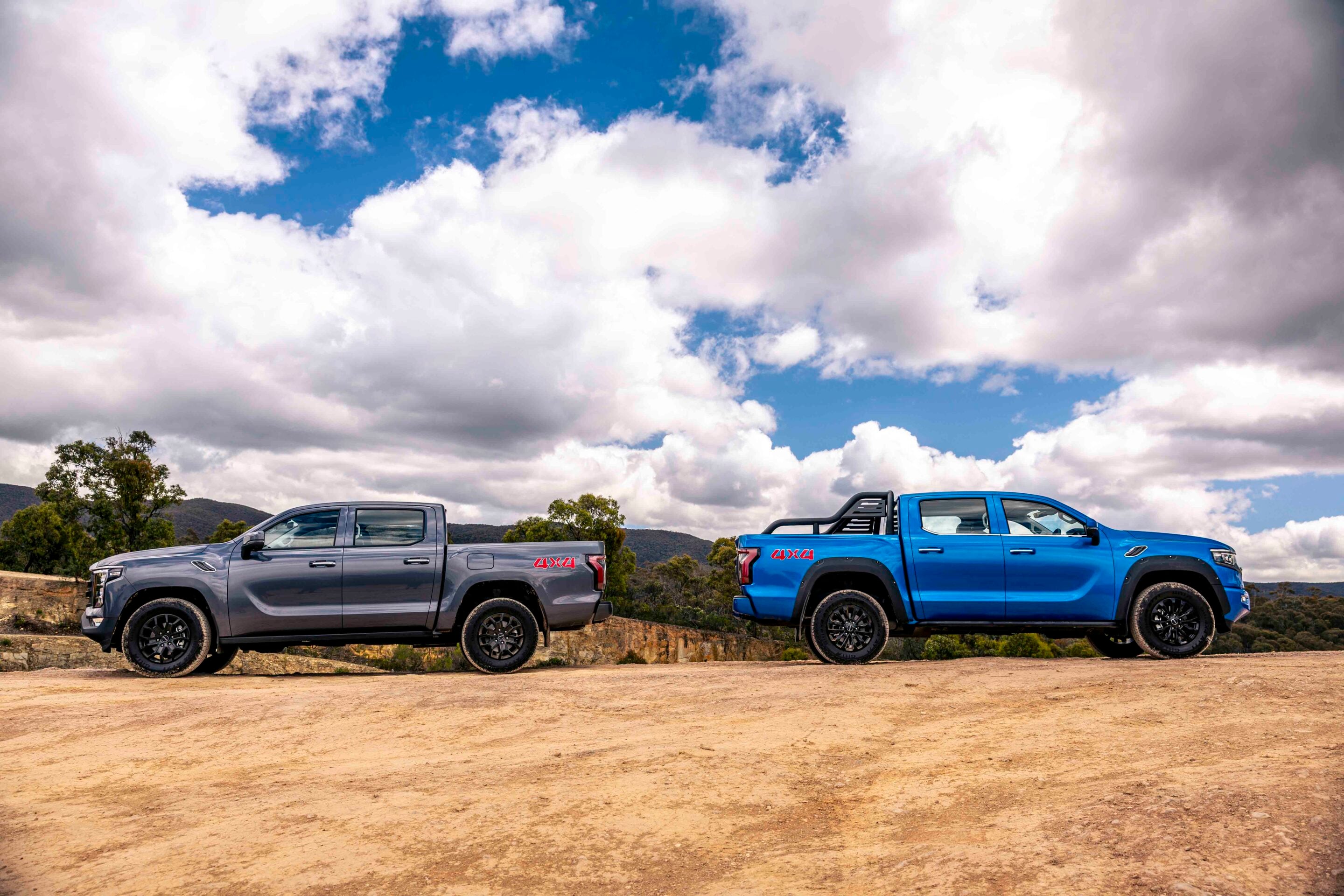
Foton Tunland pricing and model range
- V7-C 4×2: $39,990
- V7-C 4×4: $42,990 – Adds four-wheel drive, rear differential lock and additional drive modes
- V9-L 4×4: $45,990 – Adds multi-link rear suspension
- V9-S 4×4: $49,990 – Adds front and rear differential locks, panoramic sunroof and extra tech
All prices are plus on-road costs.
Powertrain performance
Both the V7 4×4 and V9-L 4×4 variants are powered by the same 120kW/450Nm 2.0-litre four-cylinder turbo-diesel backed by the popular ZF eight-speed automatic and a dual-range transfer case that also offers a 4×4 Auto mode. Both variants run a rear diff lock but no front locker, and drive modes include Eco, Standard, Sport, Sand, Mud and Snow.
All Tunlands run a 48-volt hybrid system. This is what some manufacturers call a mild-hybrid setup, although Toyota doesn’t apply the hybrid label to the 48-volt system in its diesel models. The system doesn’t offer EV-only propulsion and can’t be charged manually from an external source.
For a simple mild-hybrid system, it was surprising to feel the heavy deceleration from the battery-regeneration function in the driveline. It’s also a bit annoying, as it changes the way the vehicle coasts when you lift off the throttle.
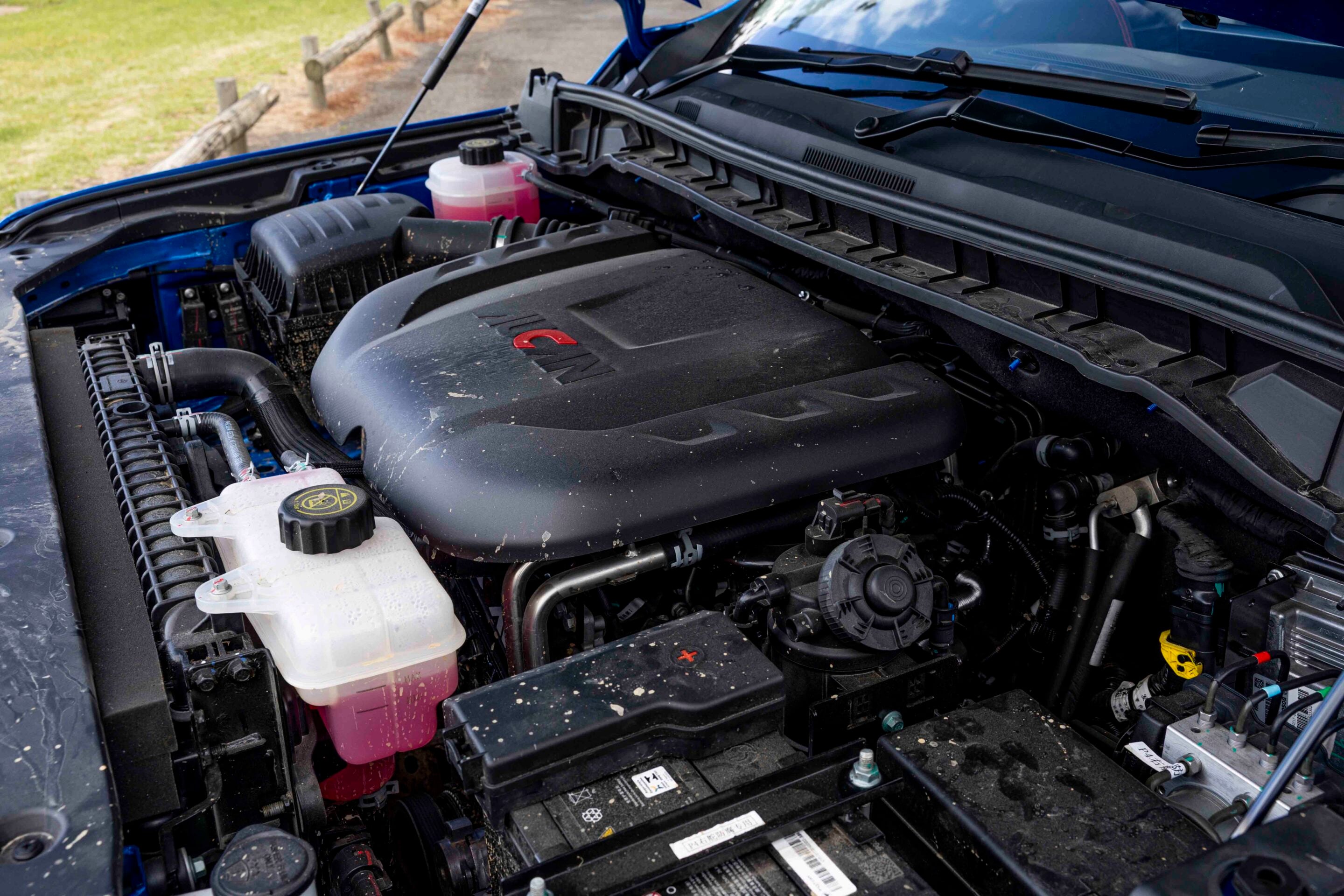
While this new 2.0-litre engine isn’t manufactured by Cummins, as the previous 2.8 was, it’s claimed to have been co-developed with Cummins, which operates a diesel engine manufacturing facility in Beijing as part of a joint venture with Foton. The drivetrain’s performance reflects its modest outputs, but it gets the unladen Tunland along well enough. It’s no Ford Bi-Turbo in terms of acceleration, but it is relatively refined thanks to good cabin insulation.
We recorded slightly better fuel consumption in the V7 than the V9, although the V7 covered around 300km of highway running, while the V9 spent its time around town and on bush tracks.
The ZF auto offers little to complain about, and it’s pleasantly aided by paddle shifters behind the steering wheel for manual gear selection. A small gripe is that when engine speed drops below 1500rpm it creates a noticeable thrumming in the cabin. Because the transmission always shuffles into top gear for maximum efficiency, anything under about 90km/h triggers the thrumming as soon as it selects eighth. Yes, you can tap it back to seventh using the paddles, but it quickly shifts back to top. It’s not an issue at higher road speeds, but it’s much more noticeable around town.
Interior tech and comfort
The Tunland sits at the larger end of the midsize-ute spectrum, and that’s obvious once you climb inside – there’s plenty of room for passengers in both the front and rear rows. The seat trims are faux leather and on the firm side, with manual adjustment in the V7. The rear seat squabs fold upwards to create some handy storage space when they’re not occupied.
Ahead of the driver is a 12.3-inch digital instrument cluster, while a 14.6-inch multimedia screen dominates the centre of the dash. The system supports wired Apple CarPlay and Android Auto and includes in-built navigation. Connecting a phone for CarPlay requires finding the USB ports hidden under the centre console, and both are USB-A type only.
The V7 runs single-zone air conditioning along with manual adjustment for the seats and folding mirrors. The V9 adds power-folding mirrors, dual-zone A/C, power-adjustable and heated front seats, wireless phone charging and a 220V outlet for rear passengers.
Some of the controls operate in slightly unusual ways, but you soon get used to them after a week or so behind the wheel.
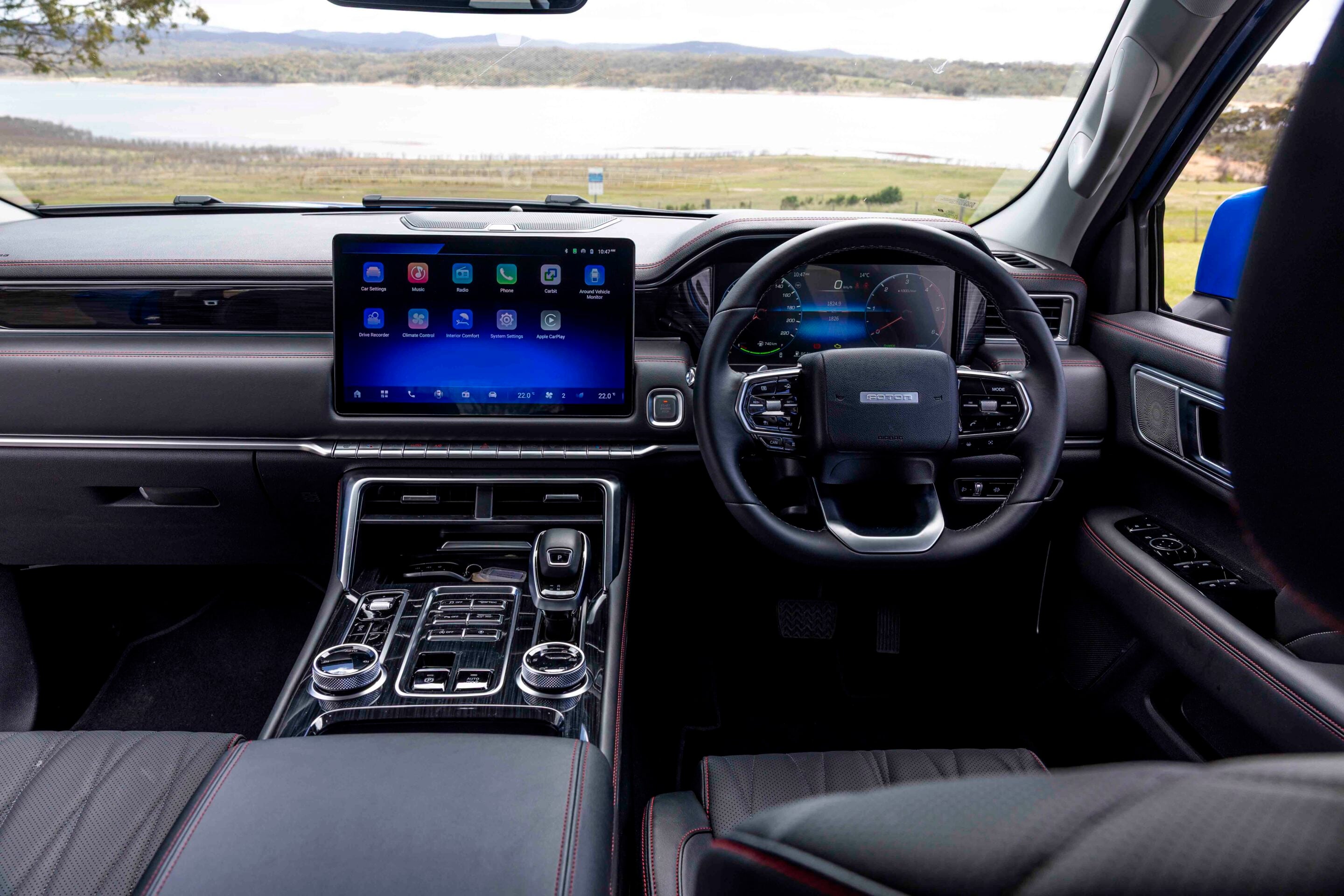
Safety kit
Safety-wise, the V7 is equipped with ESP, ABS, EBD, ETC, HDC and front and rear parking sensors.
ADAS features include Autonomous Emergency Braking with pedestrian and cyclist detection, Front Collision Warning, Lane Departure Warning, Pedestrian Collision Warning, Lane Keep Assist, Lane Centring Control, Traffic Sign Recognition, Blind Spot Detection, Rear Cross Traffic Alert and Trailer Stability Assist.
We found the Lane Centring Control particularly annoying, although it can thankfully be deactivated via a button on the steering wheel. The parking sensors and collision warning systems also caused issues off-road, occasionally preventing us from reversing when we needed to.
You can’t drive the Foton until the seatbelt is clicked on, which shouldn’t bother most users but becomes an irritation when shuffling vehicles for photos — and I reckon farmers will hate it too. You also can’t switch the engine off until the transmission is in Park. It’s nanny-grade over-complication of what should be simple actions.
Another annoyance around town is the Tunland’s habit of reducing the audio volume when you’re turning corners or in proximity to other vehicles. Listening to music is one way to ease the tedium of city traffic, but the system cuts the sound whenever there’s another car nearby – which is almost always in peak hour. Frustrating, to say the least.
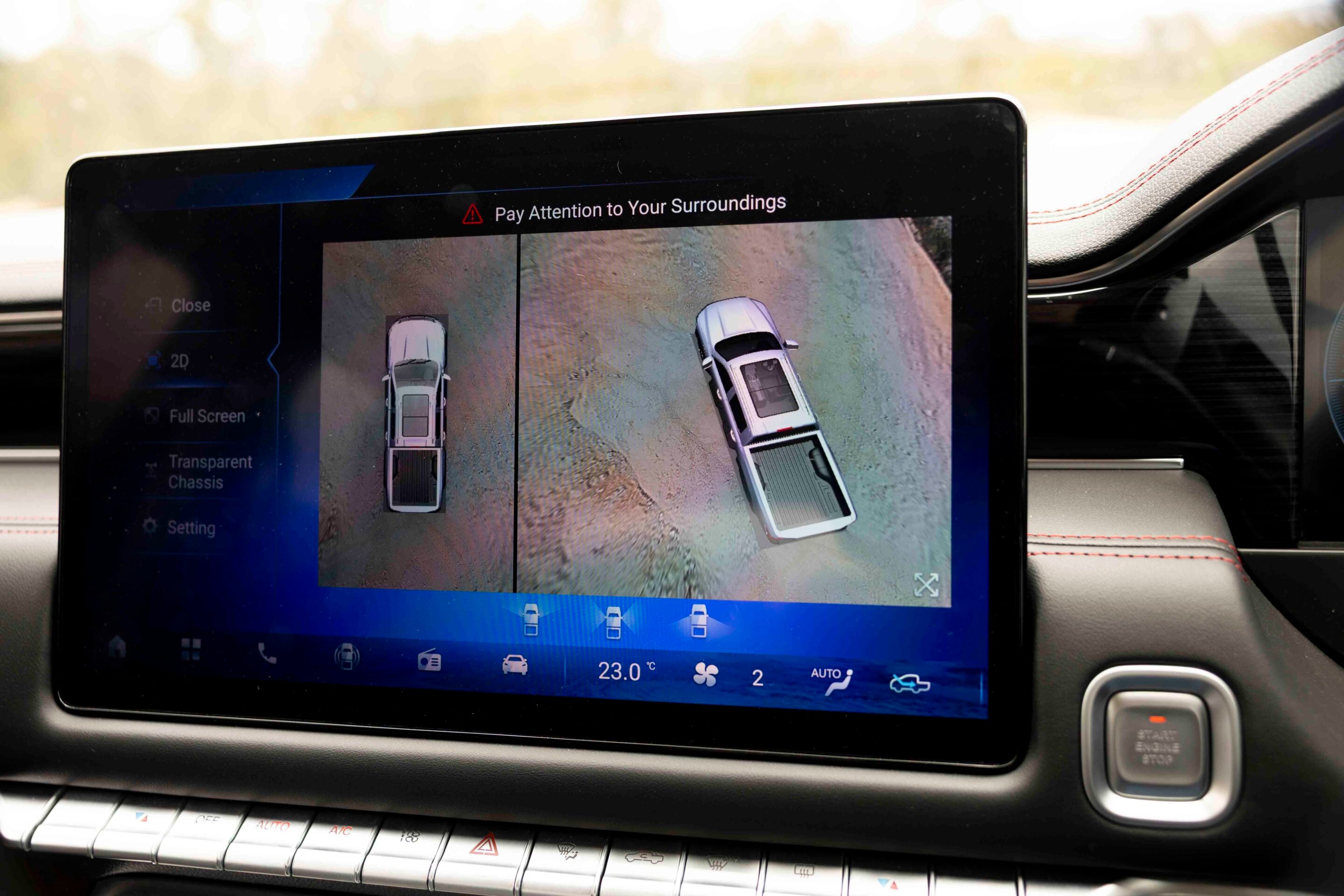
On- and off-road performance
My initial thoughts after picking up the V7 4×4 were that the engine is very quiet, the power modest and the suspension firm – often jarringly so on rough roads. By the time I’d negotiated traffic, with the audio cutting in and out due to nearby vehicles, I couldn’t wait to climb out. I appreciated the big cabin and the large screens, but some of the systems simply weren’t logical.
We copped some warm weather during our time with the Fotons, so I set the climate control to my usual 23-degree Auto setting, but the system couldn’t maintain a consistent temperature. It would blow cold air one minute and hot the next – up and down with no real stability, unlike most modern climate-control setups.
It was the same story on the highway at first, with the cruise control taking some fiddling to get working, but once activated and understood, it performed well. The suspension also settled at highway speeds, and the Tunland comfortably knocked over a couple of hours on the open road.
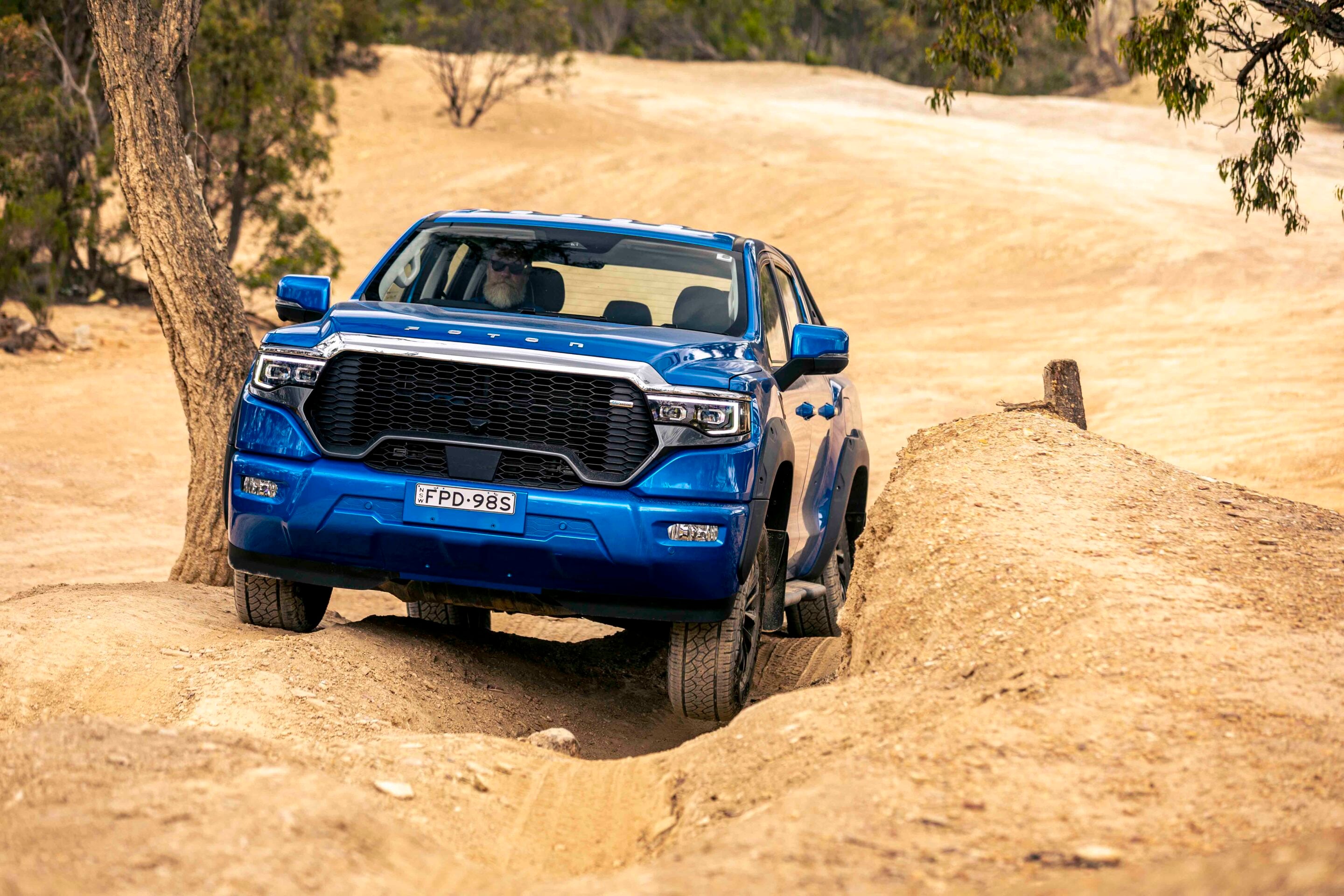
The V9 instantly feels softer and more compliant thanks to its coil-sprung rear suspension, making it noticeably more comfortable for day-to-day driving. The difference between the two setups was also evident on gravel tracks, where the V9 remained more composed while the V7 felt firmer.
The V7 performed better on the rutted hill climbs than the V9, with the leaf-sprung rear end offering enough travel and traction to scrabble up in low range without needing the rear diff lock. The V9, in contrast, simply spun its wheels in a cloud of dust regardless of the drive mode selected, and only made it up once we activated the RDL. Traction control alone wasn’t enough – something that isn’t usually the case with most utes of this ilk.
At first, I assumed the vehicles must have had an auto-locking rear diff, as there was a lot of clunking from the rear end when driving around the pit in low range, almost as if the diff was locking and unlocking. But then we discovered the RDL button on the console. The front and rear lockers fitted to the V9-S would certainly be appreciated for regular off-road use in a Tunland.
Verdict
Ateco Automotive is a major company with a long history of distributing car brands in Australia and New Zealand, so you’re not dealing with a small, unproven player if you’re considering a Foton purchase. The Tunland comes with a seven-year/unlimited-kilometre warranty, up to seven years of Foton Roadside Assistance and seven years of capped-price servicing.
The V7 and V9 Tunlands offer buyers a choice of two distinct looks. They’re big and well equipped, even if some of the tech takes a bit of getting used to and isn’t always logical in the way it operates.
They’re clearly aimed at the budget-conscious 4×4 ute buyer – a segment that’s rapidly expanding, largely due to the influx of new Chinese alternatives.
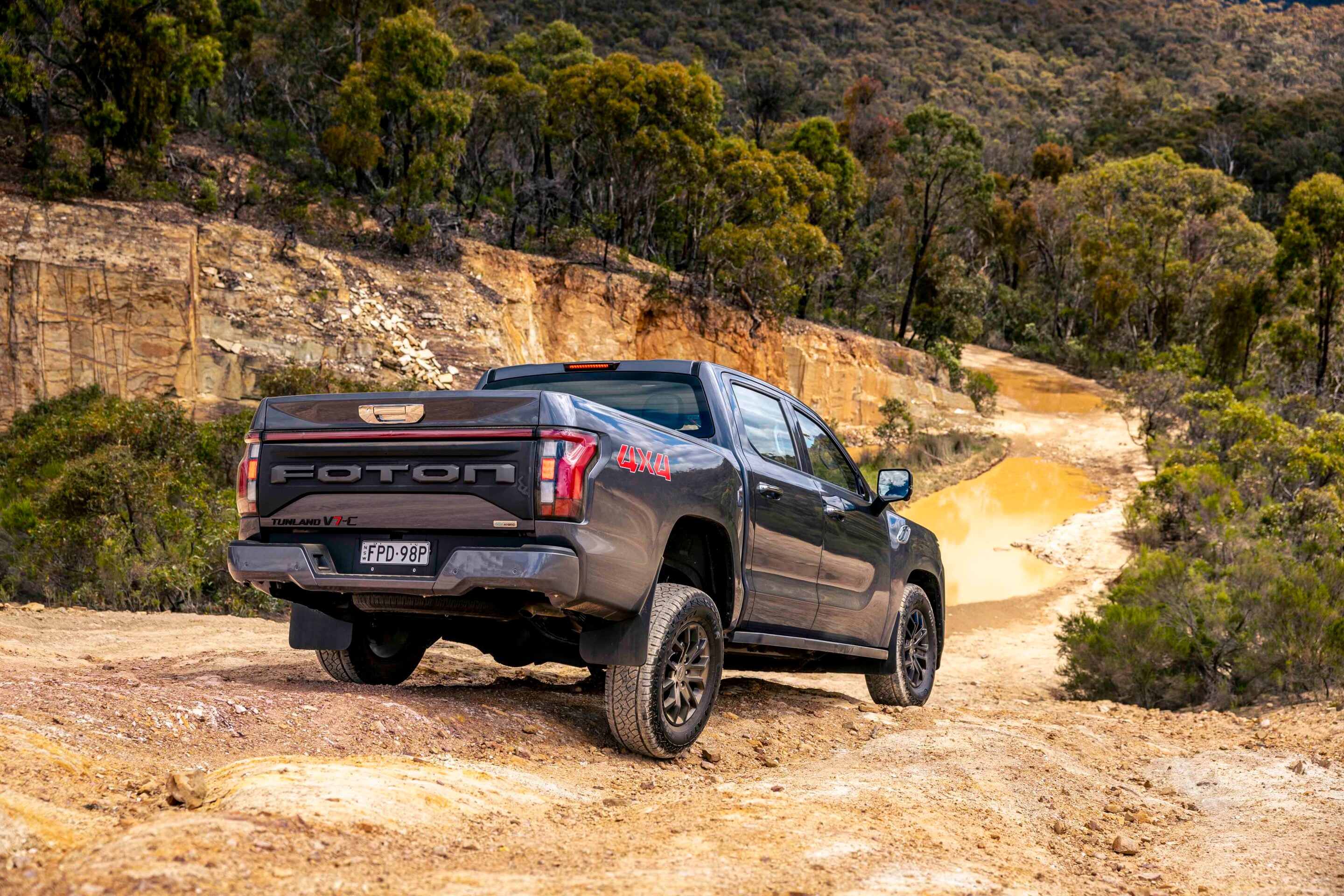
Specs
| Tunland V7-C | Tunland V9-L | |
|---|---|---|
| Price | $42,990 +ORC | $45,990 +ORC |
| Engine | 4-cylinder, turbo diesel | 4-cylinder, turbo diesel |
| Capacity | 1969cc | 1969cc |
| Max power | 120kW @ 3600rpm | 120kW @ 3600rpm |
| Max torque | 450Nm from 1500Nm-2400Nm | 450Nm from 1500Nm-2400Nm |
| Transmission | 8-speed automatic | 8-speed automatic |
| 4×4 system | Dual range part-time with 4×4 auto AWD | Dual range part-time with 4×4 auto AWD |
| Construction | 4-door ute body and tub on ladder frame chassis | 4-door ute body and tub on ladder frame chassis |
| Front suspension | Wishbone IFS with coils | Wishbone IFS with coils |
| Rear suspension | Live axle with leaf springs | Live axle with multilink and coil springs |
| Tyres | 265/70R18 | 265/70R18 |
| Weight | 2311kg | 2311kg |
| GVM | 3335kg | 3306kg |
| GCM | 6835kg | 6806kg |
| Towing capacity | 3500kg | 3500kg |
| Payload | 1024kg | 995kg |
| Seats | 5 | 5 |
| Fuel tank | 76L + 2L AdBlue | 76L + 2L AdBlue |
| ADR fuel consumption | 8.0L/100km | 8.0L/100km |
| On-test fuel consumption | 11.3L/100km | 11.8L/100km |
| Approach angle | 28 | 28 |
| Ramp-over angle | 21 | 21 |
| Departure angle | 26 | 26 |
| Ground clearance | 240mm | 240mm |
| Wading depth | 700mm | 700mm |
If Christmas has crept up on you and you’re still trying to work out what to buy your dad, you’re not alone.
And if he’s the kind of fella like a lot of the dad’s here at 4X4 Australia he already owns all the recovery gear, the camping kit and more torches than anyone needs. That’s where we reckon a 12-month 4X4 Australia magazine subscription is just the gift for him. It’s a gift that fits perfectly with how so many 4×4-loving dads actually spend their time – reading through a magazine with a coffee before a trip, flicking through pages at camp while the billy boils, or planning the next touring route from the comfort of the caravan.
Unlike a one-off gift, a subscription keeps turning up month after month, delivering fresh ideas, reviews and comparisons, new destinations and practical advice long after Christmas Day has passed.
At the newsagent, 4X4 Australia retails at $12.99 an issue, which adds up to $156 across 12 issues. A 12-month subscription costs just $109, delivered straight to the door. It’s better value and far more convenient, especially when time is running out before Christmas. And heading into 2026, there’s never been a better time to be a 4X4 Australia reader.
Over the next year we’ll be sharing even more epic Australian touring stories, exploring the tracks, camps and destinations that make this country so special to travel by four-wheel drive. Whether your dad prefers remote outback touring, coastal escapes or relaxed campervan adventures, the stories are about real trips and real experiences he can actually picture himself doing.
We’ll also be stepping up our gear testing, helping readers choose the right suspension, tyres, touring accessories and camping gear for their setup. Whether that’s a dual-cab ute, a wagon or a camper in tow.
And for the dads who love their vehicles, 2026 will deliver more head-to-head 4×4 comparisons than ever before, offering clear, real-world insights to help make smarter buying decisions.
A 4X4 Australia subscription isn’t just something to read once and put aside. It’s inspiration for the next trip, the next camp and the next great Australian adventure. If you’re stuck for a last-minute Christmas gift this year, this is one that your dad will genuinely enjoy while he’s parked up at camp or dreaming about where the next trip might take him.
Ford has confirmed its current battery-electric F-150 Lightning will be discontinued and replaced by a new extended-range electric vehicle (EREV) version – signalling a clear shift in Ford’s EV strategy.
An Extended-Range Electric Vehicle (EREV) is essentially an electric vehicle with a built-in generator (usually powered by petrol or diesel). The next-gen Lightning will use this generator-assisted electric drivetrain rather than relying solely on a large battery. It’s still driven entirely by electric motors, but the onboard generator extends the total driving range to an estimated 700 miles (1127km).
“The F-150 Lightning is a groundbreaking product that demonstrated an EV pickup can still be a great F-Series,” said Doug Field, Ford’s chief EV, digital and design officer. “Our next-generation F-150 Lightning EREV will be every bit as revolutionary.
“It delivers everything Lightning customers love – near instantaneous torque and pure electric driving. But with a high-power generator enabling an estimated range of 700+ miles, it tows like a locomotive. Heavy-duty towing and cross-country travel will be as effortless as the daily commute.”
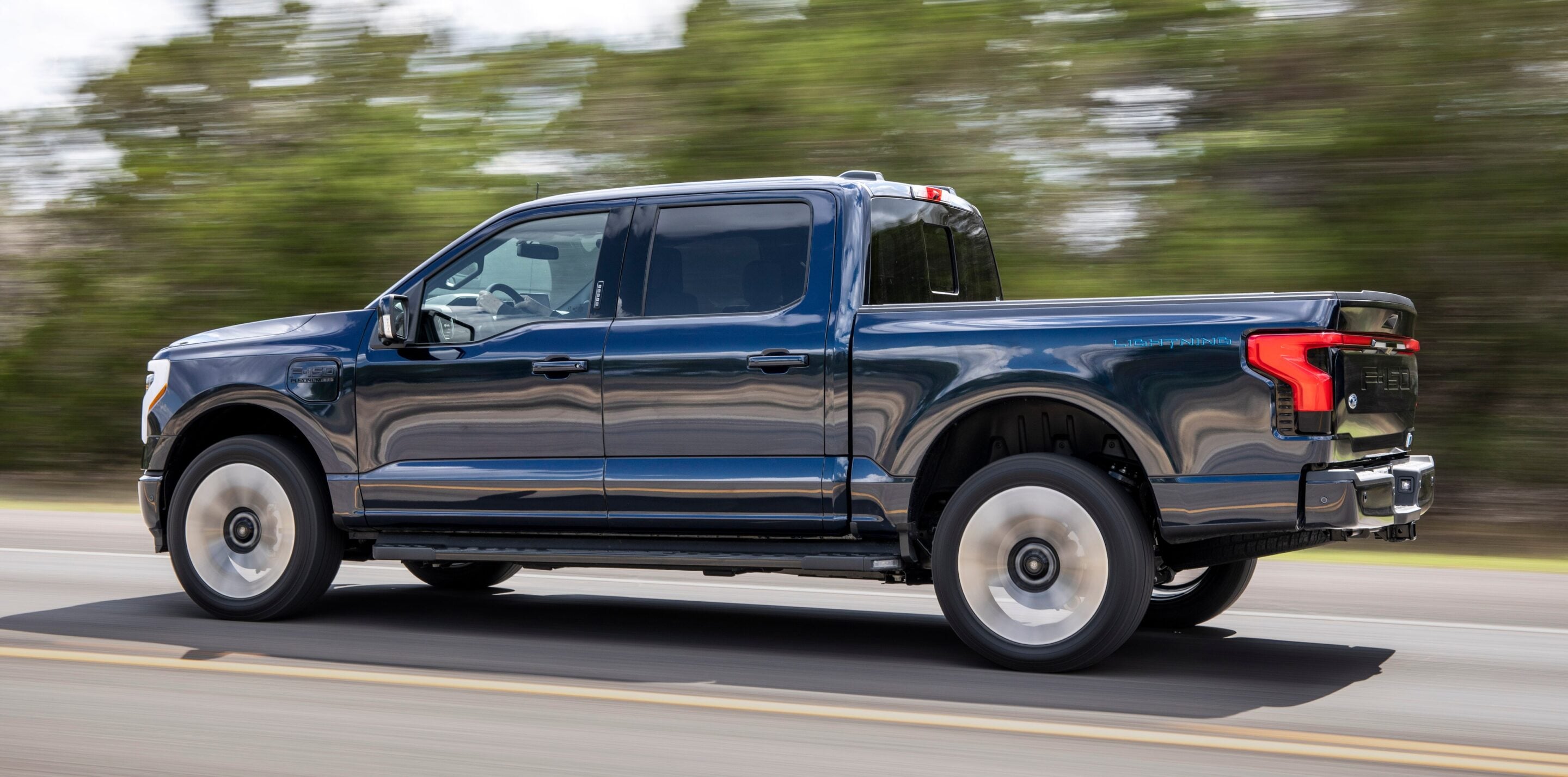
Exportable power will remain a feature, allowing the Lightning to run tools, campsite equipment, or even provide backup electricity for a home.
The new F-150 Lightning EREV will also be assembled at Ford’s Rouge Electric Vehicle Center in Dearborn, Michigan. Detailed specifications, launch timing and market availability have yet to be announced, and there’s no confirmation of right-hand-drive production or Australian availability.
While never officially part of the Ford Australia line-up, the current battery-electric Ford F-150 Lightning has dual electric motors with all-wheel drive, producing up to 433kW and 1050Nm. The extended-range battery offers around 515km of EPA-estimated range. Payload is up to 907kg and towing up to 4536 kg with the Max Trailer Tow package. It features Ford’s Pro Power Onboard and DC fast-charging up to around 150kW.
Volkswagen has confirmed details of its 2026 Amarok line-up for Australia, with the local range continuing to shift toward V6-powered variants and the introduction of the Dark Label Edition at the top end.
Built in South Africa alongside the Ford Ranger, the second-generation Amarok remains closely related under the skin, but Volkswagen Australia’s local line-up continues to skew toward higher-grade V6 variants rather than entry-level models. That approach is reflected in the simplified engine offering for 2026, with V6 models expected to make up the majority of local sales.

The headline addition is the Amarok Dark Label, reviving a name previously used on overseas Amarok variants and first flagged by Volkswagen earlier this year as a potential addition for Australia, will be powered exclusively by the 3.0-litre V6 turbo-diesel producing 184kW and 600Nm. It is paired with a 10-speed automatic transmission and Volkswagen’s permanent 4MOTION all-wheel-drive system. Braked towing capacity remains at 3500kg, keeping the Amarok a competitive shortlisted option for buyers towing caravans, boats and larger work trailers.
While the Dark Label introduces black exterior detailing, unique wheels and darker interior finishes, there are no mechanical changes compared to other V6 Amarok variants. Chassis tuning, suspension design and underbody protection are carried over, meaning off-road capability is unchanged for 2026.
Volkswagen has also confirmed the 2.0-litre bi-turbo diesel has been removed from most of the Australian range. A single-turbo four-cylinder diesel remains available in entry-level Core trim, while higher grades will be V6-only.
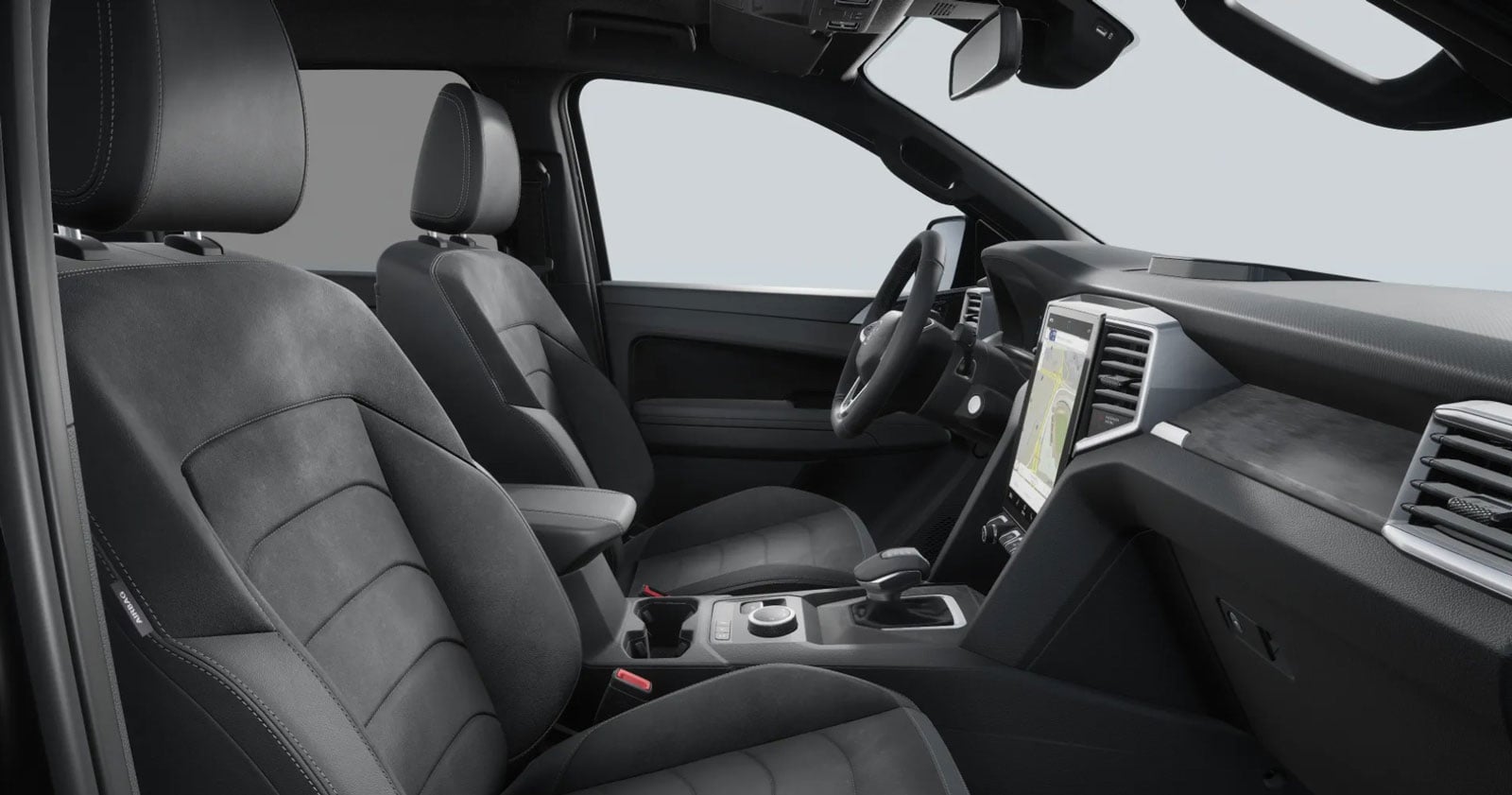
From a 4×4 perspective, V6 Amarok models continue to use a full-time all-wheel-drive system with selectable drive modes for varying terrain. Payload remains competitive at around the one-tonne mark depending on variant, allowing owners to balance touring accessories with towing loads. Tray and tub dimensions are unchanged, maintaining compatibility with existing canopies, drawer systems and touring accessories already on the market.
The Amarok PanAmericana continues as the most off-road-oriented factory option, retaining its all-terrain tyres, unique exterior treatment and V6 drivetrain. No specification changes have been announced for that variant as part of the 2026 update.
Volkswagen did not enter the Amarok into the 2025 4×4 Australia Ute of the Year program, which is a missed opportunity, as on paper the V6 Amarok has the credentials to give the Ford Ranger V6 a genuine run for its money.
Pricing for the 2026 Amarok range will be confirmed closer to its Australian on-sale date, with local deliveries expected later this year.Volkswagen has locked in its 2026 Amarok line-up for Australia, led by V6 models and a new Dark Label Edition.